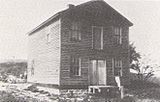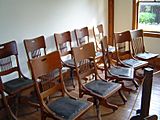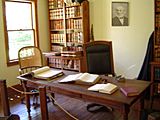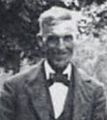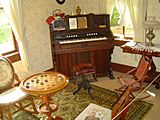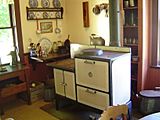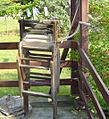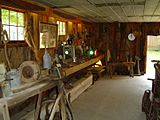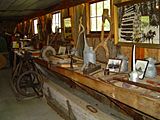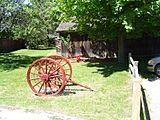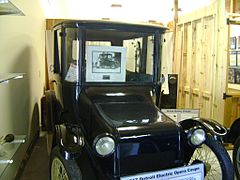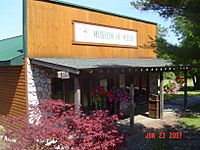White Pine Village facts for kids
Quick facts for kids Historic White Pine Village |
|
|---|---|
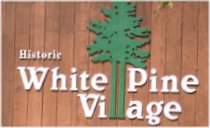
Sign on admission building of entrance
|
|
| Location | 1687 S. Lakeshore Drive, Ludington, Michigan |
| Area | 23 acres (9.3 ha) |
| Governing body | Mason County Historical Society |
| Lua error in Module:Location_map at line 420: attempt to index field 'wikibase' (a nil value). | |
White Pine Village is an exciting outdoor museum in Ludington, Michigan. It shows what life was like in the 1800s. The village has thirty old buildings filled with items from the past. You can learn about pioneer life, lumbering, music, farming, and old businesses.
Sometimes, you can even watch people demonstrate old skills. They show how to do blacksmithing, spinning, leatherworking, and candlemaking. You might also see wood carving and basket making. The oldest building is a farmhouse from 1849. It is a very special part of the museum.
Contents
Explore White Pine Village
White Pine Village is a museum where you can explore on your own. It is located just three miles south of Ludington. The village is in Mason County, Michigan.
Many people visit the village each year. Between 15,000 and 18,000 tourists come to learn about history. About 400 volunteers help keep the museum running. The village is usually open from April to October, depending on the weather.
How White Pine Village Started
The idea for this outdoor museum came from two people. Mrs. Rose Hawley, a Michigan historian, and Jerome Jorissen, a county clerk. They wanted to create a place to show pioneer history.
The Mason County Historical Society got the land in 1967. Mr. Jorissen became the supervisor of the village. Mrs. Hawley became the curator of a museum that later moved to the village. She had started a historical society in 1937. This group grew into the Mason County Historical Society, which now owns the village. Mr. Jorissen gave the first piece of land. He also helped plan and build the village.
The museum first opened in 1976. It was called "Pioneer Village" back then. Thousands of local people came to see it on the Fourth of July weekend. It showed the history of Mason County since 1850. Twelve buildings were first moved and rebuilt. These included the first Mason County Courthouse and a school. There was also a general store, a fire barn, and a blacksmith shop.
The name "Pioneer Village" was used for two years. Then, they found out another museum in Nebraska had the same name. So, they held a contest to find a new name. The winning name was Historic White Pine Village. Most people just call it "White Pine Village." The name comes from the White Pine tree. These trees were very important for the lumber industry in Michigan during the 1800s.
Buildings and Exhibits
The village has thirty buildings. Each one is like a small museum. They show different parts of Mason County's history.
Admission Building
The George Petersen Sr. Admission Building is where you enter the village. It has a gift shop and the main office. It also holds the Mason County Historical Society Research Library. This library has history books, old photos, and maps. You can find family histories and old newspaper articles here. There is even an online database to help find materials. The public can use the library for a small fee.
Burr Caswell's House
The Burr Caswell farmhouse was built in 1849. It was the first frame building in Mason County. For five years, part of the house was used as the first Mason County Courthouse. Burr Caswell was the first permanent white settler in Mason County. He was also the county's first judge. Later, he became a keeper for the Big Point Sauble lighthouse. This farmhouse was also the county's first store and first jail!
Marchido School
This old, one-room schoolhouse was built in the 1890s. It was used in rural Mason County. In 1973, it was moved to White Pine Village. Imagine learning in a school with just one room!
Doctor's Office
The doctor's office building came from Custer, Michigan. It was built in the early 1900s. Doctors like Dr. Dogood (1916) and Dr. Blanchette (1917–1947) practiced here. The building was moved to the museum and fixed up.
Rose Hawley Museum
Rose Hawley was very important in starting White Pine Village. She also helped create four museums in downtown Ludington. One museum, named after her, moved to White Pine Village in 1994. The Rose Hawley museum first opened in 1951. It moved to bigger places in 1960 and 1986. This museum now displays a special Fresnel lens. It is the original lens from the Big Sable Point Lighthouse.
Fire Station
The fire engine in the fire station was made in 1937. It is on loan to the village from Mike McDonald. He was a firefighter for the Ludington Fire Department for many years.
Burns Farmhouse
Thomas Burns and his wife Mary lived in this farmhouse. They bought it with 80 acres of land for $1,190 in 1880. They had nine children, four sons and five daughters. Sometimes, during special events, food from the early 1900s is cooked here. It shows what a typical Michigan farmhouse was like in the late 1800s.
Print Shop
The Siddon Print Shop is one of three log buildings in the village. It used to be the Siddon Post Office in the 1880s. It was taken apart and moved to White Pine Village. Then, it was rebuilt with a new roof. The other log buildings are the General Store and Trapper's Cabin.
Maritime Museum
In 2001, the Coast Guard Station in Ludington moved. The Mason County Historical Society then got the old station. It became part of White Pine Village. This museum shows the history of ships and lighthouses. You can learn about the SS Badger, Big Sable Point Light, and Ludington Light.
Lumbering Museum
This museum holds the collection of Abe Nelson, a lumberman from Ludington. He was born in Norway. His family moved to the United States when he was four. His hero was Paul Bunyan, a giant lumberjack. So, Abe made many items larger than normal.
The museum has an old pancake griddle from a lumber camp. It also has a brand used to mark logs by the Cartier Lumbering Company. There is a working 1901 sawmill. It is powered by a Huber tractor with a Stearns engine.
The museum buildings themselves are old lumber camp buildings. They were moved from Victory Township, Michigan. These two 100-year-old buildings were built by John G. Peterson. They include a blacksmith shop and a cooking shanty. You can also see Michigan logging wheels outside. These were used to drag logs out of the woods.
Car Museum
The Max K. Rahn building is home to the White Pine Village Car Museum. In 1994, the township where the village is located got a grant. This money helped create the car museum.
Blacksmith Shop
The blacksmith shop is a copy of Abe Nelson's old business. He was a railroad blacksmith in Mason County. Often, a working blacksmith is here. They dress in old-fashioned clothes. They make iron items like horseshoes and fireplace pokers.
Time Museum
The Mason County Horological Society helped create the Village Time Museum. It shows the history of timekeeping.
Post Office
This building holds items from the old Pentwater Post Office. That post office moved to a new spot in 1972. Guy VanNortwick was the postmaster from 1956 until he passed away in 1974. He wanted the items to go to a museum.
Hardware Store
The hardware building is a copy of William Anderson's Hardware Store. This store was on South Madison Street in downtown Ludington in the 1920s.
White Pine Chapel
The village staff built this chapel. It combines styles from different rural churches in Mason County. The window in the front part of the church was paid for by a local church. Another window and a cross were gifts from Grace Episcopal Church in Ludington, Michigan. One of the organs in the chapel was built around 1860. An old steeple from a church in Riverton Township, Michigan was also donated to the museum.
Museum of Music
The Museum of Music shows the 100-year history of the Scottville Clown Band. Scottville is a town about 20 miles west of White Pine Village. The museum also has old musical instruments, music equipment, and antique radios.
General Store
The Cole’s General Store is the second log building at White Pine Village. This log cabin was the home of Henry Clay Cole and his wife Olive Beebe. They owned 80 acres in Summit Township, Mason County, Michigan. The cabin was moved to the museum grounds in 1975.
Trapper's Cabin
This is the very first log cabin at White Pine Village. William Quevillon, a French trapper, built it around 1850. He built it during a hunting trip in Mason County. In 1852, Quevillon moved his family here from Grand Haven, Michigan. He used the cabin as both his home and a post office. He became the postmaster of Mason County in 1855. His cabin became the first official county post office. It delivered mail four times a year. About twenty-five letters were processed each month. He lived there with his wife Catherine and their four children. The cabin was later owned by three other people. Then, it was donated and moved to White Pine Village in 1969.
Demonstrations and Events
Sometimes, you can see special demonstrations at the village. These include blacksmithing, spinning, leatherworking, and candlemaking. You might also see wood carving and basket making. The Jorissen Barn shows how milk was handled and processed long ago.
The old town hall, from around 1900, has an ice-cream parlor. Kids love it on warm summer days! It has a marble fountain and beautiful oak cabinets.
American Civil War Re-enactment
Each summer, the village hosts re-enactments of the American Civil War. You can see people dressed in old uniforms. They show what life was like during that time.
|


